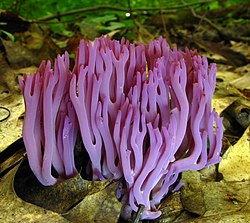Fungus
A fungus (plural: fungi) is a kind of living organism: yeasts, moulds and mushrooms that exist as a single filamentous or multicellular body. The filament is known as hyphae multinuclear with cell wall containing chitin or cellulose or both, others are parasitic saprophytic on other organisms and reproduce sexually and asexually.
| Fungi | |
|---|---|

| |
Clockwise from top left:
| |
| Scientific classification | |
| (unranked): | Opisthokonta |
| (unranked): | Holomycota |
| (unranked): | Zoosporia |
| Kingdom: | Fungi |
| Subkingdoms/Phyla/Subphyla | |
|
Dikarya (inc. Deuteromycota) Subphyla incertae sedis | |

The fungi are a separate kingdom of living things, different from animals and plants.[1][2]
Fungi have cells with nuclei. Their cell walls contain chitin, unlike the cell walls of plants, which contain cellulose. These and other differences show that the fungi form a single group of related organisms, called the Eumycota or Eumycetes. They share a common ancestor and are a monophyletic group.
Their basic mode of life is saprophytic: a fungus breaks down dead organic matter around it, and uses it as food.[3]p107
Despite the infobox on the right, the earliest fungi were probably in existence long before the Devonian period. One problem has been what to make of various traces in the Precambrian.[4]
Structure
Reproduction
Fungi reproduce both sexually and asexually. Some fungi grow mushrooms: these are fruiting bodies. Under the cap there are gills; the gills bear spores that will disperse, and may develop into new fungi. Otherwise, fungi use a sporangium to bear asexual spores by mitosis, or sexual spores by meiosis. The spores are haploid.
Fungi may be single celled or multicellular. Yeast is single-celled, and reproduces either sexually or asexually. Asexual reproduction occurs by simple budding (binary fission).
Mycelium
The mycelium is the vegetative (non-reproductive) part of a fungus. It is usually underground (or inside some other substance), and made of filaments called hyphae.
Hyphae
Hyphae look like threads, or rootlets. The mat of hyphae may be very thickly woven. The fungus uses them to extract nutrients.
Hyphae are usually syncytia. This means the cell walls (septa) are mostly not complete, and the cell nuclei are not separated from each other as in normal cells. Details differ between species.
Symbiosis
Symbiosis means living together. Lichens are a symbiosis between a fungus and an alga or bacterium. In this partnership the algal cells live inside the fungus tissue. The end result is a new mat-like life-form which clings to rock and other surfaces. About 20% of all fungi are lichenized.
Another important kind of symbiosis is mycorrhiza. This is when a fungus lives inside plant roots; most trees have mycorrhizal roots, and so do many crop plants. Both sides benefit in this arrangement.
Pathogens
Some fungi cause crop diseases; others cause serious disease in humans. Some are highly poisonous: never eat a mushroom picked in the wild unless you know what you are doing.
Uses
- Edible fungi are widely used as human food. Certain types of cheese need a fungal species to be added. The fungi give a unique flavor and texture to the cheese.
- Some fungi produce psychotropic (mind-altering) substances. Several species, most notably Psilocybin mushrooms (colloquially known as magic mushrooms), are taken for their psychedelic properties, so they are illegal in many countries around the world.
- In modern times, some fungi (for example, Penicillin) have been used as a source of antibiotics. The antibiotics are produced by many fungi as a natural defence against bacteria.
Related pages
References
- ↑ Jennings D.H. & Lysek G. 1996. Fungal biology: understanding the fungal lifestyle. Guildford, UK: Bios Scientific Publishers . ISBN 978-1-85996-150-6
- ↑ Kirk P.M. et al 2008. Dictionary of the fungi, 10th ed. Wallingford, UK: CAB. ISBN 0-85199-826-7
- ↑ Margulis L. Schwartz K.V. & Dolan M. 1999. Diversity of life: the illustrated guide to the five kingdoms. Jones & Bartlett, Sudbury MA.
- ↑ Taylor T.N; Taylor E. & Krings M. 2009. Paleobotany: the evolution of fossil plants, Chapter 2. Precambrian life, p43. 2nd ed. Academic Press, Burlington MA 01803


